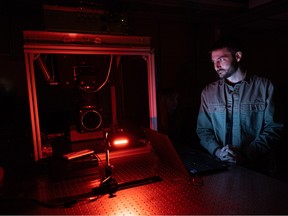Researchers at the University of Saskatchewan are making instruments to be used in an upcoming NASA-led satellite mission.

Article content
Work continues at the University of Saskatchewan on a pair of ultra-sophisticated instruments set to be put into orbit, part of a NASA satellite mission early next decade.
Professors Doug Degenstein and Adam Bourassa, both members of the U of S department of physics and engineering physics, have been leading a research team spanning 14 Canadian universities for the HAWC (high altitude aerosol, water vapour and cloud) satellite mission, which is the Canadian Space Agency’s contribution to the NASA-led Atmosphere Observing System.
Advertisement 2
Article content
Two devices have been developed at the U of S over more than a decade, dubbed ALI (Aerosol Limb Imager) and SHOW (spatial heterodyne observations of water).
Degenstein said both are, at their core, “really fancy cameras” that will help improve models used for weather and air quality forecasting and the study of climate change.
Bourassa and a team of researchers and students guided media through a lab tour on Monday, explaining along the way how the instruments gather information from beyond the spectrum of light visible to the human eye to detect the presence of aerosols in the atmosphere.
These small airborne particles affect cloud development and weather, and can come from sources including dust, wildfires, volcanoes and human industry.

While the devices themselves look like fairly nondescript boxes, each has been refined over several prototypes to be both sensitive enough to gather the data scientists need and tough enough to handle rides on balloons and NASA high-altitude aircraft, all in anticipation of their eventual date with a rocket, expected in 2031.
Article content
Advertisement 3
Article content
“The technology is mature, the science-readiness is mature,” Degenstein said, adding that at this point, the instruments are reliable enough that the team’s biggest remaining challenges are in interpreting and figuring out how to best use the data they collect.
The devices are expected to last a minimum of five years once in orbit, but Degenstein said he’s optimistic that they would remain operational far longer, pointing to previous missions where devices have lasted 10 or even 20 years.
Degenstein said the HAWC project will increase Saskatchewan’s profile to recruit, train and retain top-level talent in what’s come to be known as “Space 2.0.”
Citing the Starlink network of Internet-providing satellites as an example, Degenstein said Space 2.0 is characterized by a move away from government-led “megaprojects” in space to less expensive collaborations between researchers, industry and government to develop systems and technology.
The CSA has provided some $200 million for the HAWC project.
Jeremy Harrison, the provincial minister responsible for Innovation Saskatchewan, announced $600,000 in provincial funding over the next three years through the agency’s Innovation Science Fund.
Advertisement 4
Article content
“At the end of the day, this is going to result in more jobs, in more opportunity, in more investment — all of the things that are going to result in very positive outcomes for Saskatchewan people,” he said.
Recommended from Editorial
The news seems to be flying at us faster all the time. From COVID-19 updates to politics and crime and everything in between, it can be hard to keep up. With that in mind, the Saskatoon StarPhoenix has created an Afternoon Headlines newsletter that can be delivered daily to your inbox to help make sure you are up to date with the most vital news of the day. Click here to subscribe.
The Saskatoon Star Phoenix has created an Afternoon Headlines newsletter that can be delivered daily to your inbox so you are up to date with the most vital news of the day. Click here to subscribe.
With some online platforms blocking access to the journalism upon which you depend, our website is your destination for up-to-the-minute news, so make sure to bookmark thestarphoenix.com and sign up for our newsletters so we can keep you informed. Click here to subscribe.
Article content





